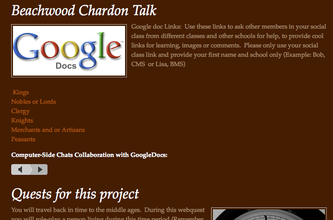Wiki's and our own online textbook
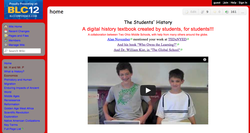
Student created wiki Textbook
As mentioned by Alan November at TEDxNYED March 5, 2011.
It all started with a basic question, “how do you engage students and allow them to show what they know”. Burgeoning technologies require teachers to rethink assessment and adapt to their students. Teachers prepare students for their future, not our past. Life does not occur in a vacuum, yet too often textbooks and curriculum categorize and isolate historical episodes. Our students connected the historical dots using written summaries, hyper-links, digital imagery, and iMovie. The ultimate goal of this book is not only to explain important moments in history, but also understand the long-term effects of each moment.
A project of this nature, allows students to disseminate knowledge in a digital format that is congruent to the world in which they live. Our students are digital natives and this new technological paradigm allows for the democratization of knowledge. Wiki technology and the ability to instantaneously communicate across cultures and physical boundaries means that nothing our students create is isolated. We not only want our students to learn, but understand how the puzzle pieces fit to create the world in which we live.
As 21st century educators, Garth and myself wanted our students to have an opportunity to collaborate between our schools. Students in Garth's classes and mine used Google Docs to engage each other in conversation concerning topics in our 7th grade curriculum. Students found other students with similar interests and began to research information, in-depth, and then add their digital content to the online textbook. Student-created text, podcasts, Power Points, hyperlinks, etc show what they know. 7th grade students, in different schools, in different cities, in different counties, collaborated in a digital setting to create knowledge.
It all started with a basic question, “how do you engage students and allow them to show what they know”. Burgeoning technologies require teachers to rethink assessment and adapt to their students. Teachers prepare students for their future, not our past. Life does not occur in a vacuum, yet too often textbooks and curriculum categorize and isolate historical episodes. Our students connected the historical dots using written summaries, hyper-links, digital imagery, and iMovie. The ultimate goal of this book is not only to explain important moments in history, but also understand the long-term effects of each moment.
A project of this nature, allows students to disseminate knowledge in a digital format that is congruent to the world in which they live. Our students are digital natives and this new technological paradigm allows for the democratization of knowledge. Wiki technology and the ability to instantaneously communicate across cultures and physical boundaries means that nothing our students create is isolated. We not only want our students to learn, but understand how the puzzle pieces fit to create the world in which we live.
As 21st century educators, Garth and myself wanted our students to have an opportunity to collaborate between our schools. Students in Garth's classes and mine used Google Docs to engage each other in conversation concerning topics in our 7th grade curriculum. Students found other students with similar interests and began to research information, in-depth, and then add their digital content to the online textbook. Student-created text, podcasts, Power Points, hyperlinks, etc show what they know. 7th grade students, in different schools, in different cities, in different counties, collaborated in a digital setting to create knowledge.
A normal day in our classrooms....

Student to Student Collaboration

We, as teachers, need to go beyond the concept of student collaboration being constrained by the walls of our schools. Students need to be enabled to collaborate across school districts, states and even countries. The image to the left is from a local paper's story concerning Garth's and my students working together to review information from our World History class. Students are collaborating (google docs), communicating (skype) and learning in real-time, using technology (and butcher paper) to create and synthesize information. Sir Ken Robinson recently said that we have to change the metaphor of education from an industrial model, to an agricultural model. Students need to be facilitated with a learning environment that encourages organic growth as an individual. Education cannot be linear, students collaborating with other students from everywhere in the world helps create a classroom were students are encouraged to collaborate and create knowledge that engages them and creates a desire to learn.
Teacher to Teacher Collaboration
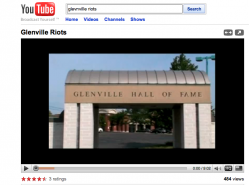
Glenville Roits
Inquiry Learning:
The video to the right was created during a summer workshop. The workshop focused on urban history in Cleveland, Ohio. Garth and I listened to a speech given by Carl Stokes, Cleveland's mayor at the time, and were inspired to look deeper at the history of Cleveland leading up to the Glenville Riots. We went to Glenville and created a short video to introduce students to the history of the area. The idea was that history teachers can also be historians; investigating historical moments and then allowing students to further discover what was happening. As teacher and historian, we gave students a base of knowledge, but more importantly, we raised questions and left them unanswered. This provided the motivation for students to become historians and learn the answers to their questions through their research. We empowered students to become the historian and use inquiry-based learning to understand local/national history.
The video to the right was created during a summer workshop. The workshop focused on urban history in Cleveland, Ohio. Garth and I listened to a speech given by Carl Stokes, Cleveland's mayor at the time, and were inspired to look deeper at the history of Cleveland leading up to the Glenville Riots. We went to Glenville and created a short video to introduce students to the history of the area. The idea was that history teachers can also be historians; investigating historical moments and then allowing students to further discover what was happening. As teacher and historian, we gave students a base of knowledge, but more importantly, we raised questions and left them unanswered. This provided the motivation for students to become historians and learn the answers to their questions through their research. We empowered students to become the historian and use inquiry-based learning to understand local/national history.
Digital Movies and online viewing

End of the year project
Students are learning how to become directors with free movie development software (Mac: Imovie and PC: Movie Maker). This software allows students to make digital films of content they are studying in school to present to the world on sites like teacher tube, Youtube and others.
The school year starts with students "Doing History". They spend several weeks learning interview strategies, types of questions, and research skills. They then study a time period in history that would correspond with the years their parents were in middle and high school. They then develop questions about the life their parents had when they were in middle and high school. Then using digital cameras they photography images from there parents experiences (old photo's, yearbooks, report card, teacher comments, etc.) and create a movie about life in 1976, or 1983 with their parents as the star. They learn valuable 21st century skills doing this and parents treasure the DVD they get as a gift--the lesson goes on
Once these skills are developed they are often asked to build more movies as alternative assessment of materials they are learning. In fact, the final project of the year is either adding to the online textbook or building an imovie called "Connect the Dots". The image above is linked to many example of this assignment on Teacher Tube. The Enduring Impacts video below was created in Dec. 2010, by a 12 year old. Outstanding.
The school year starts with students "Doing History". They spend several weeks learning interview strategies, types of questions, and research skills. They then study a time period in history that would correspond with the years their parents were in middle and high school. They then develop questions about the life their parents had when they were in middle and high school. Then using digital cameras they photography images from there parents experiences (old photo's, yearbooks, report card, teacher comments, etc.) and create a movie about life in 1976, or 1983 with their parents as the star. They learn valuable 21st century skills doing this and parents treasure the DVD they get as a gift--the lesson goes on
Once these skills are developed they are often asked to build more movies as alternative assessment of materials they are learning. In fact, the final project of the year is either adding to the online textbook or building an imovie called "Connect the Dots". The image above is linked to many example of this assignment on Teacher Tube. The Enduring Impacts video below was created in Dec. 2010, by a 12 year old. Outstanding.
Webquests
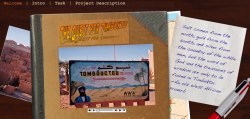
The following webquest was develop so that students could independently start a project while I was presenting at the 12th Global Chinese Conference on Computers in Education, East Lansing, Michigan. May 4-8, 2008. Students begin the webquest by watching an enhanced podcast I made that summarized the project. In groups of four they went on the quest to discover the hidden treasures of Timbuktu. The final project for this webquest was to create an iMovie outlining what they learned. Students presented their iMovie to the class. Click on the image to view the complete webquest.
Collaborative Work
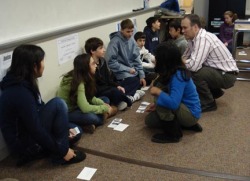
In collaboration with the Cleveland Art Museum, students at BMS engaged in three days of role-playing about trade along the Silk Road. Joe Ionna, education liaison from the CMA, worked with students who were pretending to be trading goods alone the Silk Road (photo). Joe also brought the China "Art To Go" with him and using an Elmo projector let students see objects from the "China Past" exhibit at the Cleveland Art Museum. After Joe finished his work with the students, their work began. Students then studied a variety of topics about China and developed podcasts on what they learned. To finish the project students built an interactive website (this site has been taken down and hope to get it back up soon) that was built to house these projects. Students then burned the project onto DVD’s, for CMA to use at other schools in the region.
